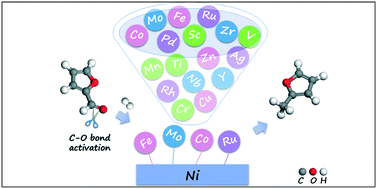Oxygen binding energy of doped metal: a shortcut to efficient Ni-based bimetallic catalysts for the hydrodeoxygenation reaction†
Abstract
Hydrodeoxygenation (HDO), one of the effective approaches of C–O bond scission, plays a crucial role in biomass-derived oxygenate conversion to high value-added chemicals and biofuels. Herein, we systematically investigated the HDO reaction of furfural (FAL) to 2-methylfuran (2-MF) over 17 kinds of Ni-based bimetallic catalysts based on periodic density functional theory (DFT) calculations. The Ni-based partner (3d and 4d metals) has an important influence on the catalytic performance toward the FAL HDO reaction, which modifies the Ni electronic environment and induces the bimetal d orbital overlap, giving rise to changes in adsorption configuration and reaction activity. A specific correlation between the oxygen binding energy (OBE) value and energy barrier of C–OH scission/*OH species hydrogenation suggests that OBE serves as the most appropriate descriptor to characterize the activity of bimetallic catalysts. Due to the competitive relationship between C–O scission and *OH species hydrogenation, a trade-off of OBE has been built to promote C–O scission and hydrogenation activity simultaneously, in which Ni–M (M = Fe, Co, Mo, or Ru) bimetallic catalysts show prominent catalytic performance. Besides, we revealed that this descriptor can be extended to other bimetallic catalysts (CoV, CoFe, CuCo). Based on the calculation prediction, we prepared several alloys (NiCu, NiCo and NiZr). A series of characterization techniques (HRTEM, EDS, XPS, H2-TPR) indicated the formation of the alloys, whose catalytic evaluations verify that Ni-based catalysts (e.g., NiCo) with a compromise OBE value (from −4.00 to −2.00 eV) exhibit enhanced catalytic behavior towards FAL HDO to 2-MF, superior to other ones (e.g., NiCu: OBE value > −2.00 eV; NiZr: OBE value < −4.00 eV). This work offers a feasible strategy to design bimetallic catalysts for the HDO reaction based on the electronic environment and chemical nature of doped metals.



 Please wait while we load your content...
Please wait while we load your content...